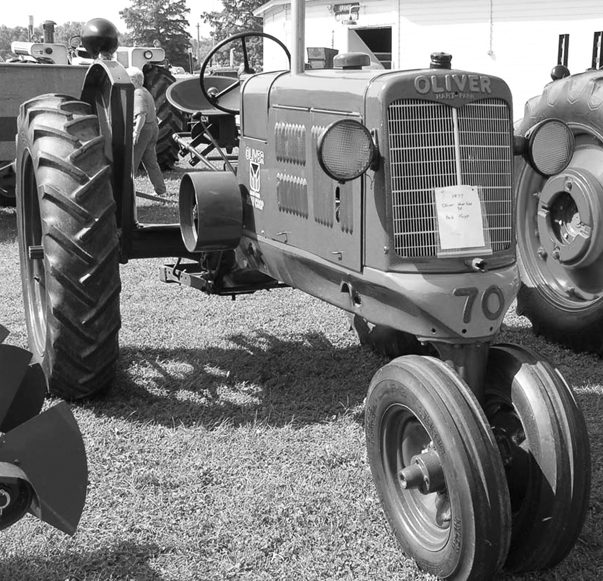On February 23, 1929, Charles City, Iowa, residents read startling news in the Charles City Daily Press: There was to be a $50 million merger between the Hart-Parr Company, one of the city’s major firms, the Oliver Plow Works and Nichols & Shepard Company.
Effective April, 2, Hart-Parr became the Hart-Parr Division of the Oliver Farm Equipment Co. The resulting company was now in a position to offer most any machine a farmer would need: Hart-Parr made tractors, Oliver, of South Bend, Indiana, plows & tillage tools, and Nichols-Shepard, of Battle Creek, Michigan, harvesting machinery.
Meanwhile, on January 1st, 1928, Oscar Eggen had been hired by Hart-Parr as an engineer at $350 per month and, of course, he went with the new company.
New chief engineer
In 1930, less than a year after the stock market crash, Eggen became chief engineer at the Hart-Parr Division, a bad time for the firm. The Great Depression hit Oliver Hart-Parr Company, as well as Charles City, where Oliver H-P was the main employer, hard, and during 1931, ‘32’ and ‘33, very few employees were on the job.
In November, 1930, the few remaining employees at Hart-Parr took a $10 pay cut and by 1932, the plant was shut down with only a few salaried supervisors kept on at much reduced salaries.
One of these was Oscar Eggen, who, with a very few dedicated and under-paid engineers, kept busy during those dark years designing a completely new tractor, even though it wasn’t at all clear that it would ever go into production.
In 1933, Franklin Roosevelt was elected president of the United States and declared a “bank holiday,” during which every bank in the country was closed. Oliver’s plant in Charles City closed as well, with only plant manager Roy Melvin on hand, and he wasn’t being paid.

Fortunes looking up
Later in the year however, a few orders for spare parts trickled in and about 200 workers were brought back, a figure that more than doubled during the next year.
In October a new Hart-Parr 28-44 on rubber tires and sporting chromed headlights was displayed on the Firestone exhibit at the Chicago World’s Fair. During 1934, operations at Hart-Parr gradually increased and by year’s end there were almost 500 employees on the job and sales had nearly doubled.
In 1935, the company felt itself in a solid enough financial condition to bring out an all new tractor and issued the following announcement: “Out of Tomorrow, The Oliver Row Crop ‘’70’’ tractor,” which gives… “more hours to live because the ‘70’ does more types of work; it’s a pleasure to be the tractor operator when there’s a new Oliver ‘70’ on the farm.”
Futuristic design
Although not Oliver’s first row crop machine, the 18-27 Row Crop had come out in 1930, the Row Crop 70 was the first with a high-compression 6-cylinder engine for burning gasoline (a lower compression engine was available for burning distillate or kerosene).
Eggen had studied automobile design and incorporated a classy slanted and V-shaped grill over the radiator, with the “Oliver” name displayed at the top in large letters above a much smaller “Hart-Parr.”
There was a fancy, winged radiator cap (these caps are hot items among today’s collectors), and a smooth rounded hood and gas tank. Vertically louvered side panels covered the engine compartment, while smaller panels enclosed the space beneath the gas tank, giving the tractor a sleek, modern automotive look.
The transmission provided four forward speeds, ranging from 2.4 to 5.9 mph. The seat was unique with a steel rod frame which supported a cloth hammock.
Row-crop clearance and an adjustable wheel tread were provided, with large diameter rear wheels mounted on splined bar axles. The rear wheels could be Oliver’s Tip-Toe steel wheels or 8.25-40 rubber tires.
Optional equipment included a power lift, PTO, belt pulley, lights, and an electric starter.
The high compression, six-cylinder engine was a first on a production tractor, while the slanted, V-shaped radiator grill and sleek, louvered sheet metal really set the 70 apart from contemporary tractors that were square and utilitarian with all parts exposed.
Beating the rivals
Although not new ideas, the optional power lift, and electric starter and lights gave the stylish Oliver 70 features that few of its competitors could match.
Implements for the Model 70 included 2 and 4 row cultivators of many configurations, a rear mounted mower and 2 and 4 row planters. In 1936 a standard-tread and an orchard version of the Model 70 were introduced and a year later, Oliver introduced an even more streamlined Model 70 with an oval grill and horizontally louvered engine side covers, while the Hart-Parr name was dropped.
So, unlike Deere and International Harvester, who hired the high-priced industrial designers, Raymond Loewy and Henry Dreyfus, to design their tractors, just a few underpaid Hart-Parr engineers working on a shoestring came up with one of the earliest streamlined, or “styled,” tractors, a machine that set Oliver on the road to prosperity for many more years.
By the way, I happen to have one cast iron headlight bracket for one of these tractors if anyone can use it.












When did the Oliver 60 come out?
Great article! I’m interested in your spare headlight bracket.